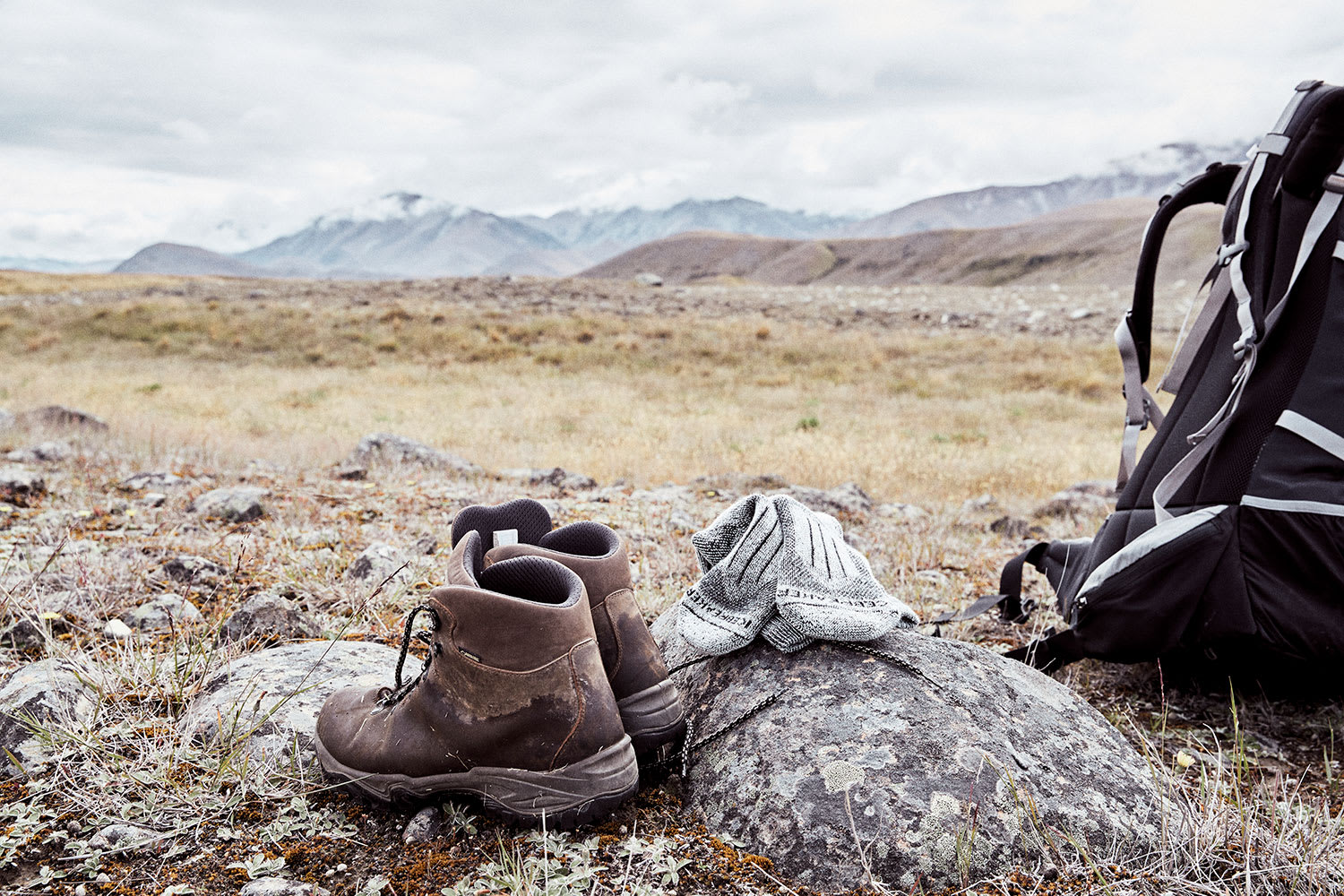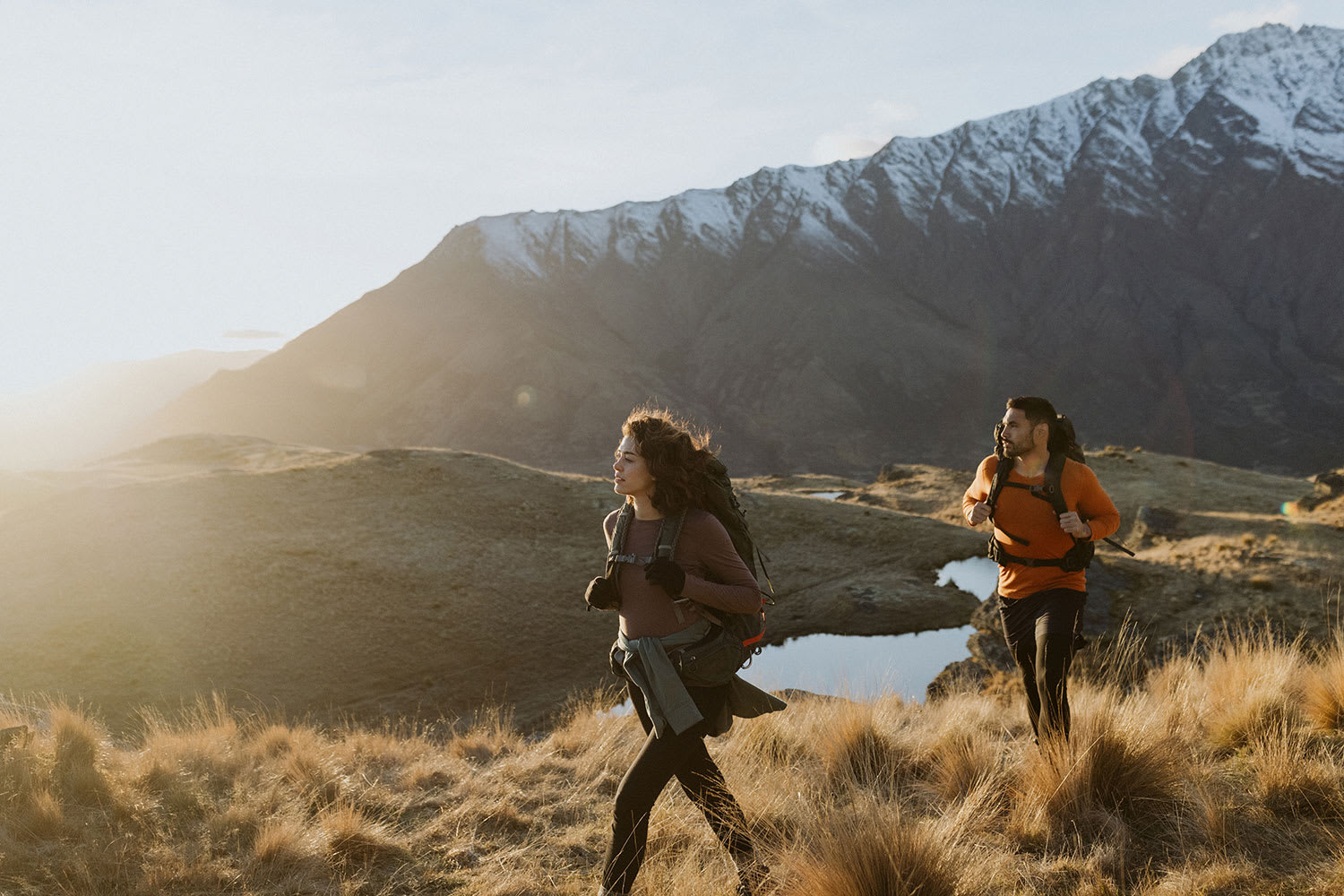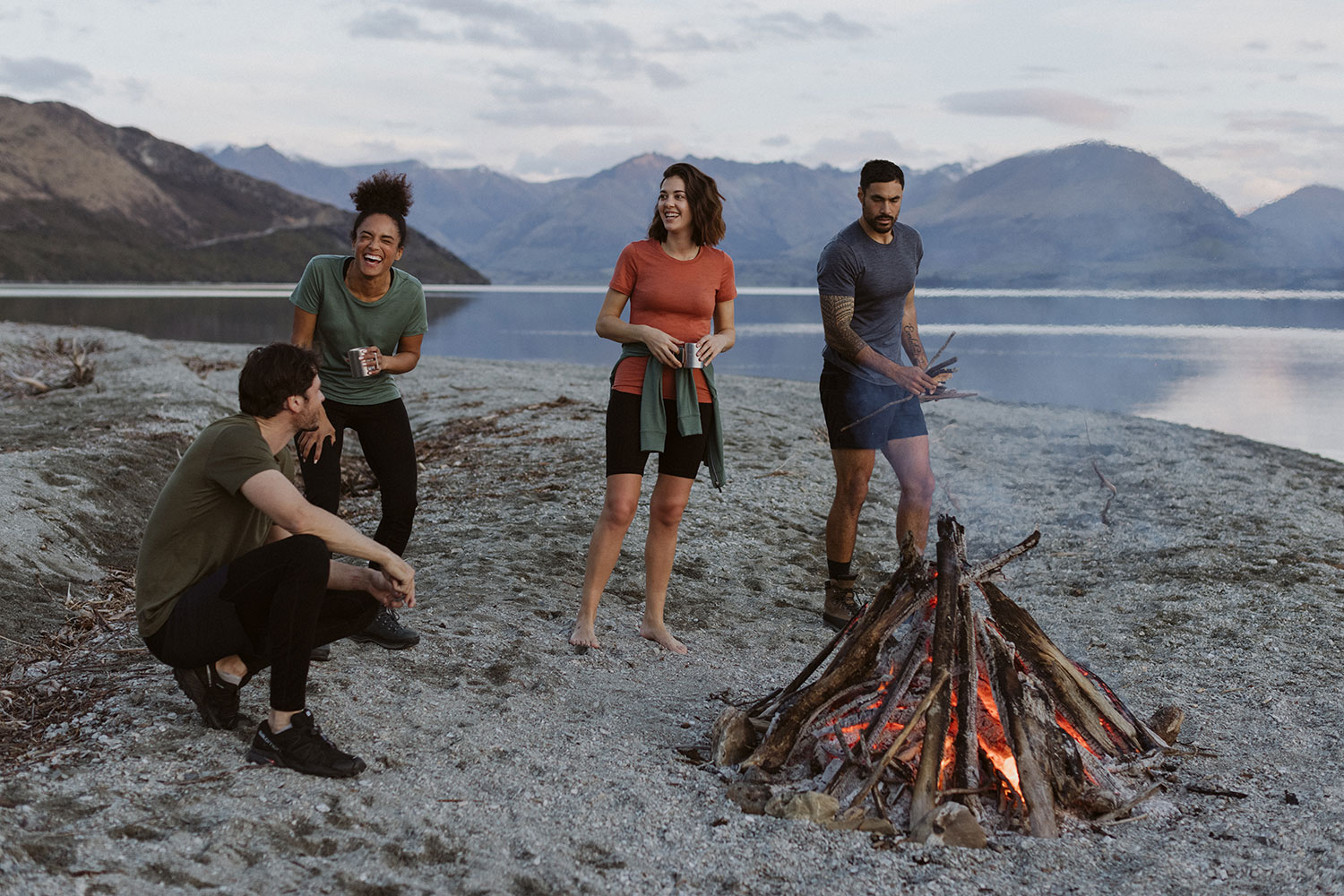Enjoying A Hiking Holiday In Oceania
October, 26th 2022 | icebreaker
Oceania is a region full of snow-capped mountains, epic glaciers, rich rainforests, and pristine beaches – a veritable paradise for hikers! Whether you’re a light walker or a hardcore mountaineer, your next adventure is waiting here. There are plenty of marked trails and tours, or you can explore some of Earth’s last untamed areas steeped in otherworldly myths. In this guide, we’ll cover the basics you need to know before setting off on your trek, and some of the best trails for your travel wishes.
Hiking in Oceania
The region of Oceania covers thousands of islands across the Pacific Ocean, each with its own unique environment and points of interest. There are three main island forms:
Continental Islands
These land masses are defined by tectonic activities that separated them from their continental attachments. All three have mountain ranges, and sometimes volcanic features, but also have distinctly different environmental processes.
● Australia
● New Zealand
● Papua New Guinea
High Islands
These are volcanic islands built up from underwater eruptions. The islands have a steep central peak with ridges and valleys pushing outward to the coast. The famous string of volcanoes around the Pacific Ocean, known as the “Ring of Fire”, marks the convergence of the Pacific and Australian tectonic plates.
● Fiji
● Vanuatu
● The Solomon Islands
Low Islands
Also known as coral islands, low islands are made of coral reef buildup around eroded volcanic islands. They typically are shaped like an irregular ring of small land masses around a lagoon.
● Polynesia (including Samoa, Tuvalu, Tonga, and Hawaii)
● The Marshall Islands
● Nauru
● Kiribati
● Guam
Mountain Hiking
Most impressive mountains in Oceania are in Australia, New Zealand, and Papua New Guinea. In Australia, the most famous are the Great Dividing Range, which holds the Australian Alps and the Snowy Mountains, and the Blue Mountain Range. Only the Australian Alps earn deep snowfall in mainland Australia; within them, the Snowy Mountains hold the five highest peaks of the mainland and are the center of the ski industry. The Blue Mountains are not nearly as high, but are famous for their enchanting landscape and wildlife, and are a UNESCO World Heritage Area. The highest points in Australia include Mount Kosciuszko (2,228m) of the Great Dividing Range and Mount Werong (1,189m) of the Blue Mountains.
New Zealand is home to three key ranges: the Southern Alps, the Kaikoura Ranges, and the Tararua Range. The Southern Alps span almost the entirety of the South Island and hold New Zealand's highest peak, Aoraki / Mount Cook (3,724m). This peak is an icon for mountaineers, as it is the deadliest mountain in New Zealand and Sir Edmund Hillary’s last challenge before Mt Everest.
Papua New Guinea holds two impressive peaks in Oceania: Mt Victoria (4,038m) in the Owen Stanley Range and Mt Wilhelm (4,509m) in the Bismarck Range. While not technically in Oceania, mountaineers also refer to Indonesia’s Sudirman Range in the Papua province.
Puncak Jaya, or Cartensz Pyramid, is the highest peak in Oceania at 4,884m, with Sumantri a close second (4,870m).
When hiking in the mountains, make sure you’re physically and mentally prepared. Gear up for the elements with strategic layers and materials like Merino Wool and strong protective hiking boots. Consider that you are climbing, and the changing altitude will impact your body’s fitness – bring plenty of water and account for rest and photo breaks on the trail. For more gear guidance, check out our guide to layering and our guide to backpacking.

Volcano and glacier hiking
When one thinks of volcanoes in Oceania, the Ring of Fire comes to mind first. Only some are explosive and have created steep, sharp peaks, while others have a dome shape from successive lava flows. In Hawaii sits Kilauea, the most active volcano in the world, and Mauna Kea, Oceania’s highest shield volcano (4,205m). These peaks even receive snowfall and can be skied on during the winter. The mountains of the North Island of New Zealand are also primarily volcanic, including Mt Egmont and the Tongariro group.
Glaciers are less common in Oceania, but still present and mostly accessible. New Zealand’s Southern Alps are most famous for their glaciated peaks and are a world-class alpine climbing and ski mountaineering destination. The largest glacier in New Zealand is the 29 km long Tasman Glacier. Outside of New Zealand is Puncak Jaya in Indonesia, which holds several glaciers.
Desert hiking
When you think “desert”, the Australian Outback likely comes to mind first. Australia actually has a total of 10 officially defined deserts, making up nearly 20% of the landmass.
1. Great Victoria Desert (348,750sq.km)
2. Great Sandy Desert (267,250sq.km)
3. Tanami Desert (184,500sq.km)
4. Simpson Desert (176,500sq.km)
5. Gibson Desert (156,000sq.km)
6. Little Sandy Desert (111,500sq.km)
7. Strzelecki Desert (80,250sq.km)
8. Sturt Stony Desert (29,750sq.km)
9. Tirari Desert (15,250sq.km)
10. Pedirka Desert (1250sq. km)
Outside of Australia, there are a few desert regions in Oceania. New Zealand hosts the 2,371.07 sq.km Maniototo Plain and the Rangipo Desert. Hawaii holds the unique Kaʻū Desert, which is made up mostly of dried lava remnants, volcanic ash, and sand.
Desert hiking has some different considerations than other activities: water and sun protection are essentials for an enjoyable trip. Make sure you start the trail with a large, full vessel of clean drinking water, are dressed in breathable, lightweight clothing, and have a hat and/or sunglasses to protect your eyes and face.
Rainforest hiking
Many of the smaller islands in Oceania hold rainforests due to their near-equatorial location, including Samoa, Niue, the Solomon Islands, New Caledonia, and Vanuatu. These areas hold awe-inspiring amounts of flora and fauna, many of which are only found here. New Guinea, the eastern half of Papua New Guinea, boasts the third largest rainforest in the world. There are approximately 730 species of birds, several varieties of trees, at least five species of wallabies, and the world’s largest butterfly, the Queen Alexandra’s Birdwing.
New Zealand holds some temperate rainforests on the west coast of the South Island. Australia’s remaining tropical rainforests are in north Queensland, including the Daintree Rainforest, and some temperate rainforests in far south Victoria and Tasmania.
When hiking the rainforest, remember you’ll be surrounded by humidity and vegetation. This is awesome, but it’s important to be loaded up with insect repellant and breathable, quick-dry clothing to maintain comfort while you sweat. Solid, high-quality hiking boots with good tread and waterproof uppers are a must, since the ground is often soft and moist. Critters in the rainforest are exciting to see, but make sure you look with your eyes and not your hands – avoid touching anything other than trail signs and clearly marked ropes.
Beach and coastal hiking
There are many incredible beaches and coastlines in the Oceania region, either to spend the day lounging or to hike along. Some of the most famous in Australia include Wineglass Bay in Tasmania, the Coast Track in Royal National Park, and the Great Ocean Road. One of New Zealand’s Great Walks, Abel Tasman Coastal Track, rewards trekkers with a world-famous route along stunning beaches.
Beach and coastal hiking is beautiful, refreshing, and grants travelers the best of land and sea. There are plenty of wilderness coastal trails in Oceania, many that require some climbing abilities and rock knowledge, but also plenty of walking tracks. No matter your skill level, it’s important to wear solid shoes with good tread to minimize the risk of slipping on loose sand and rocks. Also, protect yourself from burns and scrapes with lightweight sleeves and pants, sun block, a hat and sunglasses. Weather between land and sea is often fickle, so be prepared with a lightweight rain jacket and/or windbreaker. Research your trail before you go, since the tides may change the conditions – there might even be some times in the day when the tide washes out part of the trail!

Hiking in Australia
Australia boasts world-famous hiking locations, ranging from leisurely day trips to intense treks into the wilderness. Travel across scenic coastlines, summit stunning mountains, brave the Outback, and meet vibrant rainforest critters all in one country!
Mountains
Australia’s mountain ranges are known for their ethereal beauty and exciting wildlife. There are plenty of hiking trails to conquer, whether you’re a lifelong mountaineers or a beginner.
1. Blue Gum Forest, NSW
The World Heritage-listed Blue Mountains National Park is simply stunning. The Blue Gum Forest is a special place for Aussie bushwalkers, and can be hiked through as a day trip or an overnight adventure. The Blue Mountains are home to thriving wildlife, bubbling creeks, and fragrant eucalyptus trees, with plenty of lookout points and secret groves. One of the most popular routes starts at Perry’s Lookdown, descends into the Grose Valley, and loops back for a full 5km, 4-hour round-trip.
2. Mount Gower, NSW
Lord Howe Island’s unique ecology earned it a World Heritage listing and fame amongst nature lovers. Visitor numbers are actually limited in order to protect the natural environment, so if you wrangle a spot, you can get up close to pure nature. As a day hike, climb through mist forests to Mount Gower’s peak and catch incredible views: a panorama of the island, neighboring Mt. Lidgbird, the lagoon, the northern settlement, and the world’s largest sea stack. Round trip, this moderate hike is 14km and takes 7-9 hours – not for the faint of heart, but doable for most fairly active individuals.
3. Mount Kosciuszko, NSW
Mount Kosciuszko is Australia’s highest peak, but you don’t need to be a mountaineer to summit it. The round-trip Kosciuszko walk uses Thredbo’s Kosciuszko Express chairlift, so the summit is only a 14km loop. Climb over granite outcrops, wildflowers, a glacier-gouged lake, and the Snowy River – and pause to take in the scenery. The moderate walk is an excellent opportunity to practice your mountaineering without needing to be an expert.
Deserts
Australia’s vast amount of desert means plenty of scenic views and hidden gems. While famed outdoors enthusiasts test their skills in the Outback, for those who are just taking a holiday, these three areas are thrilling day trips.
1. Carnarvon Gorge, Queensland
This area is pretty isolated and requires your own vehicle to get to it, but the sheer, untouched beauty is worth it! There are lots of hiking trails in the area, with the longest at just 19km, with several detours and hidden spots to discover, making this an excellent full-day trip. As you follow the Gorge track, you can swim in the Rock Pools, meditate in the Moss garden, explore Warrumbah and Boowinda Bluffs, and discover many more incredible spots.
2. Kings Canyon, Northern Territory
In the heart of Central Australia lies Kings Canyon, boasting stunning views of towering cliff faces, ancient rock domes, and lovely plant-lined rock pools. The well-marked Rim Walk will let you see all of this on a 6-7km half-day hike. The trail goes up the side of Kings Canyon, over the top, and down the other side, and is generally flat aside from a steep ascent at the top.
3. Jatbula Trail, Northern Territory
For those who came to Australia to brave its infamous environments, the Jatbula Trail through bush landscapes is a moderate but exciting adventure. The 62km one-way walk follows a traditional path over woodlands, sandstone plateaus, forests, and rivines. The journey starts at Nitmiluk Gorge, crosses the Arnhem Land escarpment, and finishes at breathtaking Edith Falls over 5-6 days. You can find plenty of guided trips for your abilities and comfort level, but no matter how you approach it, this unique trek reveals iconic Australian landscapes.
Rainforests
Australia’s remaining rainforests are teeming with wildlife and luscious scenery, offering visitors a fun day of exploring plants and waterfalls. While many of the hiking trails are relatively easy walks, note that you’re still on tricky terrain, so make sure you and your group are prepared.
1. Springbrook National Park, Queensland
Springbrook National Park is part of the Shield Volcano Group of the UNESCO World Heritage-listed rainforests, and all hikers who visit agree that it is something special. In particular, the Natural Bridge area includes a unique rock formation carved by the force of a nearby waterfall over a basalt cave. The walk is only 1 km and very tame, meaning the whole family can enjoy ancient trees, vibrant wildlife, and waterfall-curtained caves. Inside these caves await delicate rock formations, bright glowworms, and stunning views.
2. Grand Canyon Walk, NSW
This 6km loop is over 100 years old and well-deserving of its world heritage listing. The canyon and trailhead are located in the Blue Mountains, so just getting there is an adventure all its own! This 3-4 hour hike isn’t difficult, and the path to and from the Evans Lookout is well maintained, but you will have a several hundred-metre climb into and out of the canyon. The path winds along the base of sandstone cliffs and through the rainforest, with several iconic points like rock pools, caves, and waterfalls.
3. Daintree National Park, Queensland
The Daintree Rainforest is estimated at around 180 million years old – and looks fantastic for its age! There are plenty of walking trails to do on a day trip, but a weekend trip will give you enough time to really explore. You can start at the Daintree Discovery Centre and cross the aerial walkway over the rainforest to the viewing platforms on Canopy Tower. Here, you can observe the whole rainforest and look for animals and unique plant life. Want to get down and dirty? Trek the Bush Tucker Trail to be transported back to the Jurassic period through ancient plants and replicas of animals.
Beaches and coasts
A continental island, Australia has an incredible coastline and some of the most famous beaches in the world. In fact, many travelers come to Australia just to do days-long trips along the east and west coasts, by car or by foot.
1. Wineglass Bay, Tasmania
One of the most beautiful beaches in the world, Wineglass Bay is an artwork of orange brushed rocks, aquamarine sea, and pristine white sand. The trail to this paradise is easy to follow and only about an hour one way, but does have a long, steep staircase to the lookout. Most families can walk it, and enjoy spotting the playful Tasmanian wildlife.
2. Great Ocean Road, Torquay
The Great Ocean Road is a must-do on any Australian holiday itinerary; while it’s known as a self-drive trip, many travelers praise doing it on foot. The drive can be done in a day, or over a few days to be able to fully soak up the views, but walking is certainly a 2-3 day journey. Walking tracks originate in Torquay along the southwest coast, with your first iconic stop being the Aireys Inlet Lighthouse. The full trail winds over sandy beaches and incredible cliffs.
3. Coast Track, Royal National Park, NSW
This epic overnight hike covers 26km of the Royal National Park, starting in a romantic seaside village and ending at a lookout atop a beautiful forest. You’ll adventure along cliffs, over sandy beaches and small creeks, and through the Curracurrong Falls – Sydney’s only waterfall that flows straight to the ocean. Trekkers stop for swims at the beach, spend the night camping or in oceanside accommodations, and spend the second half of the journey climbing through thick rainforest to the top of the escarpment. Overall, the walk is a moderate one, with gentle but long climbing.

New Zealand hiking locations
The islands of New Zealand are heralded around the world for their natural beauty – and they have special reverence amongst outdoors enthusiasts. The variety of trails and landscapes offer exciting, breathtaking adventures for all types of travelers.
Mountains
Hike through New Zealand’s snow-capped mountains, glacial rivers, and winding valleys. Despite the small land mass, hikers can spend anywhere from an afternoon to multiple days exploring the mountains.
1. Mt Cook, South Island
Mount Cook National Park is one of the best known areas of New Zealand; Aoraki/Mount Cook is New Zealand’s tallest peak. The Hooker Valley Track in the park follows the glacial Hooker River through low shrubbery and snowy mountains, leading to a lake with floating bits of icebergs! The walk is only 10km along a flat, well-maintained path, so all ages and fitness levels can enjoy it and get close to the famed mountain.
2. Tongariro Alpine Crossing, North Island
Tongariro Alpine Crossing is a World Heritage Site and New Zealand’s oldest national park. As you circle blue lakes, climb up the craters of both active and extinct volcanoes, and cross ancient lava fields, you’ll understand why the place holds such spiritual and cultural importance to New Zealand’s indigenous people. Additionally, Mt. Ngauruhoe is on this hike, also known as Mt. Doom in ‘The Lord of the Rings’. The hike is just about 20km long and take 6-9 hours depending on fitness level, making it a moderate to difficult trail.
3. Routeburn Track, South Island
This 33km long hike in the Southern Alps has been named one of the 10 best walks of New Zealand by many travel blogs and companies. The path is fairly well-marked and dotted with swing bridges and epic viewpoints, making it an intermediate level trail. Crossing through both Mount Aspiring and Fiordland National Parks takes 2-4 days, full of alpine valleys, glaciers, and vibrant forests full of interesting native wildlife.
Volcanoes and glaciers
New Zealand is home to over 3,000 glaciers and 9 volcanoes (which are active!), most of which are accessible by either hiking or helicopter. The Franz Josef and Fox Glaciers are two of the most famous, as they are only 2 of 3 glaciers in the world to flow into a rainforest. Explore both fire and ice during your visit, and every scene in between.
1. Rotorua Caldera, North Island
Rotorua Caldera is one of several volcanoes within the Taupo Volcanic Zone on New Zealand’s North Island. After a violent eruption, the volcano’s summit collapsed, forming the peaceful, lake-filled caldera. Along its shores are hot springs and geysers, and at its center is the sacred lava dome Mokoia. Visitors can swim in the lake and hot springs, fish, and rent kayaks or boats to explore. The caldera itself stretches 16km across, making it a nice walk from the lakeside city of Rotorua.
2. Fox Glacier, South Island
An accessible glacier on the west coast of the South Island, the trails between Fox Glacier and Franz Josef Glacier are relatively easy, flat walks. The glacier flows from the Southern Alps into a temperate rainforest, making it a truly unique adventure. You can see the glacier from the beautiful nearby Lake Matheson, enjoy the glacier from a helicopter flight, or take an ice-hiking adventure. The nearby town boasts lovely cafes and glow worm caves, making this a fun day trip for all ages and skill levels.
3. Franz Josef Glacier, South Island
ox Glacier’s twin, the Franz Josef Glacier has a walking trail that will take you nearly to its terminal face. A heli-hike or guided ice walk can get you actually touching this natural monument, or enjoy views from a kayak or paddleboard on the nearby lake. Some hikes in the area ascend steep valley sides to grant amazing views of the glacier, or find a guided hike for the whole group.
Rainforests
Both of New Zealand’s main islands hold temperate rainforests, often right beneath glaciers and mountain peaks. As you hike through National Parks, you can cross through entirely different worlds, each one more exciting than the next.
1. Lake Waikaremoana Track, North Island
Lake Waikaremoana is located in the rugged Te Urewera rainforest, the largest on the North Island, and the ancestral home of the Māori iwi (tribe) Ngāi Tūhoe. Over the entire 42km Great Walk, which takes 3-4 days, you will explore the rainforest, stunning waterfalls, and the “goblin forest”. The tricky terrain makes this a moderate trail, but your efforts will be rewarded – you’ll discover local history and lore, marvel at the shimmering lake, and check out plants unique to the region.
2. The Catlins Chaslands Area, South Island
In the southeastern corner of the South Island lies a leafy rainforest full of three-tiered waterfalls, petrified forest over 160 million years old, and playful fur seals and blue penguins. The Catlins region has many trails and areas to suit every hiker’s desire, be it waterfalls or rivers or forests or mountains. The Cheslands Area specifically has easy walking paths between beaches, waterfalls, and ancient history. Seafaring visitors are rewarded with the Cathedral Caves on Waipati Beach, two connected limestone sea caves. McLean Falls on the Tautuku River crosses through moss-rich forest; this area is truly one with treasures for the entire group.
3. Milford Sound, South Island
Milford Sound is seated within the Fiordland temperate rainforest (so you can hike the Routeburn track to see this rainforest too!). It showcases beeches and podocarps, old but traditional New Zealand flora, which dominate the forests. The entire Milford Track takes 4 days over 53km, and winds through both mountains and forest: waterfalls, suspension bridges, mountain peaks, and mirror-smooth lakes.
Beaches and coasts
1. Abel Tasman Coastal Track, South Island
While the Abel Tasman Coast Track is one of the easiest trails in New Zealand, don’t let that fool you – it’s also one of the most stunning! The full 51km trail winds through the National Park’s dazzling water, white sand beaches, intimate coves, and rock pools. You can walk the whole trail over 3-5 days, or take a water taxi or kayak between locations. You can also pop into sections for a day of hiking, kayaking, and excellent snorkeling. As you hike further in, you’ll be rewarded with a seal colony, hidden bays, and peaceful forests.
2. Te Henga Walkway, North Island
This 10km coastal trail leads visitors from beach to beach, with clifftop views, bridges, and dunes. There are some steep uphills, making this trail a moderate challenge, but the adventure is beautiful.
3. Cape Foulwind Walkway, South Island
This family-friendly 3km walk takes hikers to meet a seal colony, enjoy panoramic views of Tauranga Bay, and visit a historic lighthouse. The walking path goes along coastal bluffs, dotted with information panels to explain the region’s history. The path can be walked either way between the bay and the lighthouse.
More for you

Why merino is perfect for summer hiking | icebreaker
October 2021 | null

Merino socks for hiking | icebreaker
26th August 2020 | Marie Knowles

The Ultimate Camping Essentials Checklist | icebreaker
September 2021 | null







